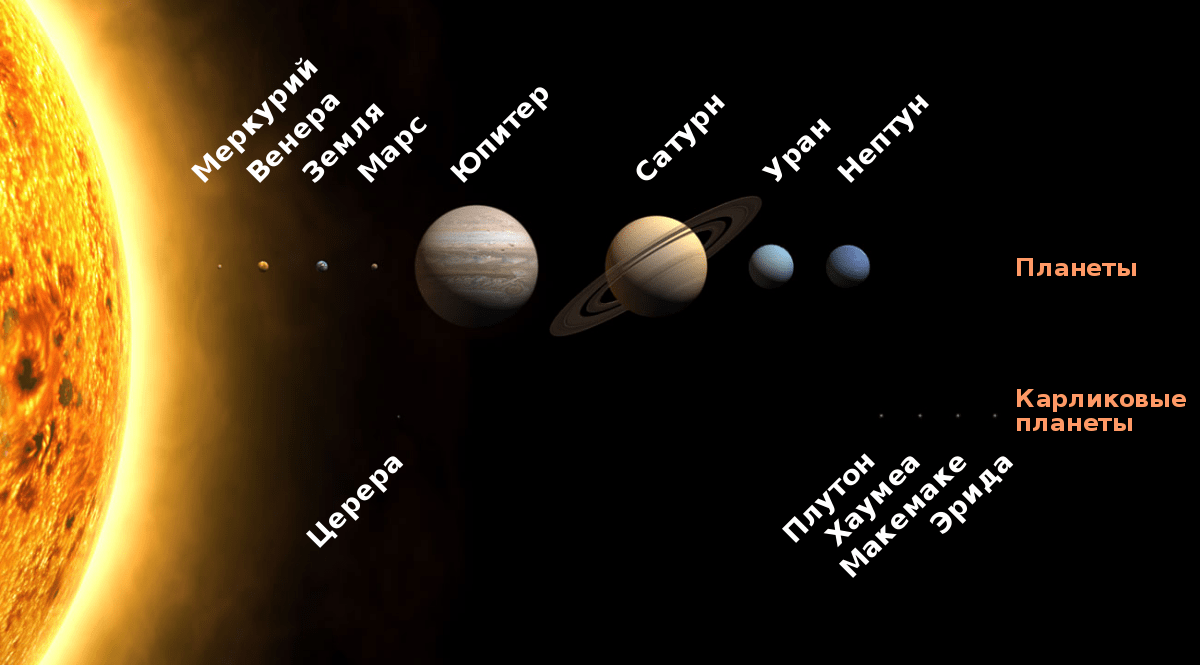
The mysterious periphery of the solar system
The outskirts of our solar system can be compared to the earth's oceans. Just like they (on a cosmic scale) are almost at our fingertips, but it is difficult for us to examine them thoroughly. We know many other more distant regions of space better than the Kuiper belt regions beyond Neptune's orbit and the Oort cloud beyond (1).
Probe New Horizons it's already halfway between Pluto and its next exploration target, object 2014 year69 w Kuiper belt. This is the region beyond the orbit of Neptune, starting at 30 AU. e. (or a. e., which is the average distance of the Earth from the Sun) and ending at about 100 a. e. from the Sun.
1. The Kuiper belt and the Oort cloud
The New Horizons unmanned aerial vehicle, which took historic photographs of Pluto in 2015, is already more than 782 million km away from it. When it reaches MU69 (2) will install as specified Alan Stern, chief scientist of the mission, the farthest peace exploration record in the history of human civilization.
Planetoid MU69 is a typical Kuiper belt object, meaning that its orbit is nearly circular and does not remain in orbital resonance with its orbital Neptune. The object was discovered by the Hubble Space Telescope in June 2014 and was chosen as one of the next targets for the New Horizons mission. Experts believe that MU69 less than 45 km in diameter. However, the more important task of the spacecraft is to study the Kuiper belt in more detail. NASA researchers want to inspect more than twenty objects in the area.
2. The flight path of the New Horizons probe
15 years of rapid change
Already in 1951 Gerard Kuiper, whose name is the near boundary of the solar system (hereinafter referred to as Oort Cloud), he predicted that asteroids also orbit outside the orbit of the outermost planet in our system, i.e. Neptune, and Pluto behind it. The first one, named 1992 KV1However, it was only discovered in 1992. The typical size of dwarf planets and Kuiper belt asteroids does not exceed a few hundred kilometers. It is estimated that the number of Kuiper belt objects with a diameter of more than 100 km reaches several hundred thousand.
The Oort Cloud, which extends beyond the Kuiper Belt, formed billions of years ago when a collapsing cloud of gas and dust formed the Sun and the planets orbiting it. The remains of unused matter were then thrown far beyond the orbits of the most distant planets. A cloud can be made up of billions of tiny bodies scattered around the sun. Its radius reaches even hundreds of thousands of astronomical units, and its total mass can be about 10-40 times the mass of the Earth. The existence of such a cloud of matter was predicted in 1950 by the Dutch astronomer Jan H. Oort. There is a suspicion that the gravitational effects of nearby stars from time to time push individual objects of the Oort cloud into our region, creating long-lived comets from them.
Fifteen years ago, in September 2002, the largest body in the solar system since the discovery of Pluto in 1930 was discovered, ushering in a new era of discovery and rapid change in the image of the solar system's periphery. It turned out that an unknown object revolves around the Sun every 288 years at a distance of 6 billion km, which is more than forty times the distance between the Earth and the Sun (Pluto and Neptune are only 4,5 billion km away). Its discoverers, astronomers at the California Institute of Technology, named it Kuaoara. According to early calculations, it should have had a diameter of 1250 km, which is more than half the diameter of Pluto (2300 km). The new banknotes have changed this size to 844,4 km.
In November 2003, the object was discovered 2003 WB 12, named later Point, on behalf of the Eskimo goddess responsible for the creation of marine animals. The essence formally belongs not to the Kuiper belt, but ETNO class - that is, something between the Kuiper belt and the Oort Cloud. Since then, our knowledge of this area began to increase along with the discoveries of other objects, among which we can name, for example, Makemake, Haume or Eris. At the same time, new questions began to arise. Even the rank of Pluto. In the end, as you know, he was excluded from the elite group of planets.
Astronomers continue to discover new boundary objects (3). One of the newest is dwarf planet Dee Dee. It is located 137 billion km from Earth. It revolves around the Sun in 1100 years. The temperature on its surface reaches -243°C. It was discovered thanks to the ALMA telescope. Its name is short for "Distant Dwarf".
3. Trans-Neptunian objects
Phantom Menace
In early 2016, we reported to MT that we had received circumstantial evidence for the existence of a ninth yet unknown planet in the solar system (4). Later, scientists at the Swedish University of Lund said that it was not formed in the solar system, but was an exoplanet captured by the Sun. Computer modelling Alexandra Mustilla and his colleagues suggest that the young sun "stole" it from another star. This could have happened when the two stars approached each other. Then the ninth planet was thrown out of its orbit by other planets and acquired a new orbit, very far from its parent star. Later, the two stars were once again far apart, but the object remained in orbit around the Sun.
Scientists from the Lund Observatory believe that their hypothesis is the most likely of all, because there is no better explanation for what is happening, including anomalies in the orbits of objects revolving around the Kuiper belt. Somewhere out there, a mysterious hypothetical planet was hiding from our eyes.
loud speech Konstantin Batygin i Mike Brown from the California Institute of Technology, who announced in January 2016 that they had found another planet far beyond the orbit of Pluto, made scientists talk about it as if they already knew that another large celestial body was orbiting somewhere on the outskirts of the solar system . . It will be slightly smaller than Neptune and will orbit the Sun in an elliptical orbit for at least 15 20-4,5. years. Batygin and Brown claim that this planet was ejected to the outskirts of the solar system, probably during the early period of its development, about XNUMX billion years ago.
Brown's team raised the issue of the difficulty in explaining the existence of the so-called Kuiper Cliff, that is, a kind of gap in the trans-Neptunian asteroid belt. This is easily explained by the gravity of an unknown massive object. The scientists also pointed to the usual statistic that for thousands of rock fragments in the Oort Cloud and the Kuiper Belt, there should be hundreds of asteroids several kilometers long and possibly one or more major planets.
4. One of the visual fantasies about Planet X.
In early 2015, NASA released observations from the Wide-Field Infrared Survey Explorer - WISE. They showed that in space at a distance of up to 10 thousand times more than from the Sun to the Earth, it was not possible to find Planet X. WISE, however, is able to detect objects as large as Saturn, and therefore a celestial body the size of Neptune could escape its attention. Therefore, scientists also continue their search with the XNUMX-meter Keck Telescope in Hawaii. So far to no avail.
It is impossible not to mention the concept of observing the mysterious "unfortunate" star, the brown dwarf – which would make the solar system a binary system. About half of the stars visible in the sky are systems consisting of two or more components. Our binary system could form a yellow dwarf (the Sun) along with a smaller and much cooler brown dwarf. However, this hypothesis seems unlikely at present. Even if the surface temperature of a brown dwarf were only a few hundred degrees, our equipment could still detect it. The Gemini Observatory, the Spitzer Telescope and WISE have already established the existence of more than ten such objects at distances of up to a hundred light years. So if the sun's satellite is really out there somewhere, we should have noticed it a long time ago.
Or maybe the planet was, but it no longer exists? American astronomer at the Southwestern Research Institute in Boulder, Colorado (SwRI), David Nesvorny, in an article published in the journal Science, proves that the presence of the so-called testis in the Kuiper belt footprint of the fifth gas giantwhich was there at the beginning of the formation of the solar system. The presence of many pieces of ice in this area would indicate the existence of a planet the size of Neptune.
Scientists refer to the core of the Kuiper belt as a set of thousands of trans-Neptunian objects with similar orbits. Nesvorny used computer simulations to model the movement of this "core" over the past 4 billion years. In his work, he used the so-called Nice Model, which describes the principles of planetary migration during the formation of the solar system.
During the migration, Neptune, located at a distance of 4,2 billion km from the Sun, suddenly shifted 7,5 million km. Astronomers don't know why this happened. The gravitational influence of other gas giants, primarily Uranus or Saturn, has been suggested, but nothing is known of any gravitational interactions between these planets. According to Nesvorny, Neptune must have remained in a gravitational relationship with some additional icy planet, which was forced out of its orbit towards the Kuiper Belt during its migration. During this process, the planet broke apart and gave rise to thousands of huge icy objects now known as its core or trans-Neptunians.
The probes of the Voyager and Pioneer series, a few years after the launch, became the first terrestrial vehicles to cross the orbit of Neptune. The missions have revealed the richness of the distant Kuiper Belt, reviving a plethora of discussions about the origin and structure of the solar system that turn out to be far beyond anyone's guess. None of the probes hit the new planet, but the escaping Pioneer 10 and 11 took on an unexpected flight path that was seen back in the 80s. And again questions arose about the gravitational source of the observed aberrations, which is probably hidden in the periphery of the solar system ...

